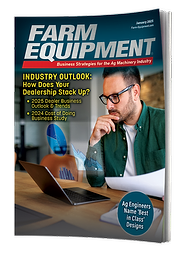As dealers expand their operations, they must establish and maintain a business model that works for them.
“When you talk about the biggest changes I’ve seen in farm equipment dealerships during my 40-plus years, the word ‘size’ comes immediately to mind: size of the dealerships, size of the farms and size of farm equipment. As farms got bigger, dealers and equipment grew right along with them. As farmers became more sophisticated businesspeople, dealers had to become better businessmen.
|
David L. Kahler, Retired Executive Director/CEO, Ohio-Michigan Equipment Dealers Assn. For more than 40 years, David Kahler has served farm equipment dealers through his association work. The roots of his career actual started in high school when he worked with the Agricultural Stabilization and Conservation Service (ASCS), an agency of the USDA. While studying at Ohio State Univ., Kahler worked for the Farm Science Review, an equipment exhibition organized by the College of Food, Agricultural and Environmental Sciences at Ohio State. He joined the Farm and Power Equipment Dealers Assn. in Ohio in 1969 as director of field services. The association eventually became the Ohio-Michigan Equipment Dealers Assn. and Kahler became associate director in 1983 and then CEO in 1986, a position he held for 23 years. He semi-retired in 2003, but has been working part-time as associate director with the Mid-America Equipment Retailers Assn., which represents dealers in Indiana and Kentucky, after it merged with the Ohio-Michigan group. Kahler is the recipient of several prestigious awards from Ohio State Univ., FFA, Agri-Broadcasters Network for his work with dealers and distributors. He is also currently one of three judges for Farm Equipment’s Dealership of the Year awards program. |
“It wasn’t that long ago, probably about 15 years, when the manufacturers were fighting the multi-store concept. They didn’t want dealers owning two or three stores; they didn’t want that at all. All of a sudden, they changed their mind and the push for multi-stores totally changed the face of the ag machinery business. Dealers were faced with a tough decision: they either needed to become buyers or sellers.
“With this push, a lot of bloodletting began taking place, and it not only affected the dealers, but their customers as well. Where famers had always done business with a particular dealer-friend, they didn’t like the fact that their local dealership was being taken over by someone two counties away. Now we’re seeing this filter down to the OPE dealer ranks, where even the average lawn and garden dealer needs to be multi-store to achieve the numbers his manufacturer believes they’ll need to expand their AOR.
“I’ve often wondered, if I was the manufacturer, what would happen if my dealers got too strong? Would they be easier or harder to deal with? And what if you have a guy covering a fourth of the state of Michigan and he hiccups for one reason or the other, who the heck are you going to find to replace him? Those have always been in the back of my mind, but the trend’s strong enough and evidently it’s not a big issue for the manufacturers.”
Controlling Costs, Maintaining Margins
“Throughout my career, the two factors that have had the most detrimental impact on dealerships is their failure to control costs and to maintain margins. It seems controlling costs has always been a problem, but it’s being compounded today because staffs are larger, dealers have more stores to manage, and the risks associated with more new and used and more expensive inventory are far more serious than when dealers had a single store to contend with.
“When it comes to maintaining margins, which is what I preached 30 years ago, I’m hearing that it’s a little easier to keep them up with larger AORs than it used to be because dealers don’t have the inline competition that the used to have. Now, they’re competing against the different colors, but the inline competition’s not quite as bad.”
Maintaining Personal Contact
“Another major change I’ve seen in the past decade or so is the personal contact between dealers and their manufacturers seems to be disappearing. There’s no doubt that the Internet and electronic communications are necessary in today’s economy. But it’s also detrimental to the personal relationships that were so prevalent not that long ago.
“As the head of the Ohio-Michigan Equipment Dealers Assn., when one of my members was having problems with his manufacturer, I knew who to call and speak with. Today, I’m not at all sure who I should be talking to.
“I was speaking to one of our members recently who told me he hadn’t seen his territory rep in six months. Of course, in the same breath he said, ‘Thank God.’ But I think this is a sign of what’s to come; where personal interactions are minimized and electronic ordering, inventory checking and other business functions replace face-to-face business. I suppose it’s cost cutting and efficiency that the manufacturers are looking for.
Getting Too Big?
“If you would have asked me 10 years ago if a dealer could get too big, I would have said, ‘Absolutely, they can get too big.’ But today, I’m not so sure and I would have a hard time arguing that point anymore. All you have to do is look at Titan Machinery and RDO. Dealers like this have a business model in place and they’re making it work. If anything, they’re examples of how dealerships need to think outside of the box.
“It’s seems like the manufacturers want to dictate to dealers how they want things done, but I’ve been advising dealers to create a business plan that works for them. I also tell them that most important thing they’re going to do is to hire the best people they possibly can and be willing to pay for the talent they need to succeed.”





